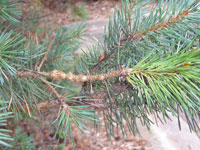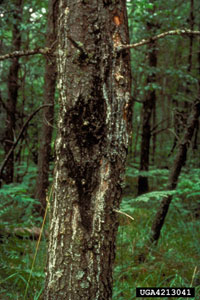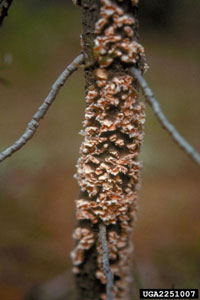Extension > Garden > Diagnose a problem > What's wrong with my plant? > Evergreen Trees and Shrubs > Pine > Woody growth or swelling
Pine > Trunk/Branches > Woody growth or swelling
1 of 2
Pine-Pine gall rust and Pine-Oak gall rust
Endocronartium harknessii and Cronartium quercuum f.sp. banksii
- Round to oblong woody galls on branches and stems
- Bark on galls cracks and releases bright orange to yellow powdery spores in spring
- Young infected trees can be killed by main stem galls
- Flagging, branch dieback, poor growth and witches' broom occurs on mature infected trees
- Most common on Jack pine, but infects many 2 or 3 needled pines
- Need a lab analysis to distinguish the two diseases
- More information on Pine-Pine gall rust
2 of 2
Comandra, Stalactiform or Sweetfern rust
Cronartium comandrae, Cronartium coleosporioides, and Cronartium comptoniae
- When severe, canopy is thin, has poor growth, needles yellow, turn brown and die
- On young stems or branches, infection may appear as a swollen, elliptical area
- Infection develops into a long, flattened, resin soaked canker on the main trunk
- Sweetfern rust cankers frequently occur near the soil level and grow up to 6 ft. long
- Stalactiform rust cankers grow up to 25 ft. long along the main trunk
- Comandra rust cankers occur on the main trunk and rarely grow over 4 ft. long
- Ridges of wound wood may be present along edges of the canker
- Pale yellow blisters of powdery spores break through cracks in bark in spring, sticky orange drops form along canker edges in late summer to fall
- Jack and ponderosa pine most severely affected, but many 2-3 needle pines are susceptible
- Differentiation between the 3 species is most accurate with a lab analysis
- More information on Comandra, Stalactiform or Sweetfern rust









